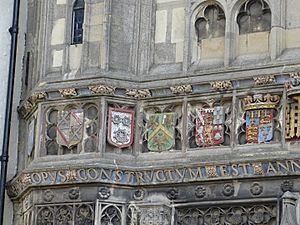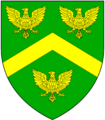John Fineux facts for kids
Sir John Fineux (born around 1441 – died 1526) was an important English judge. He became the Chief Justice of the King's Bench, which was the top judge in one of England's main courts.
Contents
Who Was Sir John Fineux?
Sir John Fineux came from a very old family in Kent, England. His father was William Fyneux, and his mother's last name was Monyngs.
People say that Sir John started studying law when he was about 28 years old. He then worked as a lawyer for 28 years before becoming a judge. He served as a judge for another 28 years! If this is true, it means he was born around 1441.
He was part of a famous law school called Gray's Inn. In 1474, he helped manage the marshlands between Tenterden and Lydd. He also became a manager for the lands belonging to the church at Christ Church, Canterbury in 1476. Some stories even say he managed 129 different estates at one time!
In 1485, he became a "serjeant-at-law," which was a special type of senior lawyer. His motto for this big moment was "Quisque suae fortunae faber," which means "Everyone is the maker of their own fortune." This was the first time a serjeant-at-law was recorded using a motto!
The next year, in 1486, he joined the King's Council, a group of advisors to the king. He also became the manager of Dover Castle in 1488. In 1489, he was made a judge for trials in Norfolk and became the king's own serjeant-at-law.
Sir John Fineux's Judicial Career
Sir John Fineux became a judge in the Court of Common Pleas on February 11, 1494. This court handled disagreements between people. Just a year later, on November 24, 1495, he was promoted to the highest position: Chief Justice of the King's Bench. This court dealt with serious crimes and cases involving the king.
He helped review petitions (requests) in Parliament in 1496 and again in 1503. He also helped manage lands for King Henry VII. In 1509, he was chosen as one of the people to carry out King Henry VII's will after the king died. He continued to be a trusted judge and advisor, even helping with petitions in Parliament in 1515.
A Big Debate About Law and Church
In 1512, a new law was passed. It said that murderers and criminals who were not priests could no longer claim "benefit of clergy." This old rule meant that if you were a priest, you could be tried in a church court instead of a regular court, which was often much more lenient. The new law was only supposed to last for one year.
However, this law caused a huge argument! A church leader named Richard Kidderminster said the law went against God's law and the church's freedom. Another person, Standish, defended the new law.
The debate became even more heated because of a murder case involving a man named Richard Hunne, who had upset the clergy. Everyone was talking about whether church members should be tried in regular courts or church courts.
King Henry VIII called a special meeting with judges and his council to discuss this important issue. Sir John Fineux played a key role in this meeting.
The Archbishop of Canterbury argued that old church leaders supported the church courts trying priests. But Sir John Fineux bravely replied that many "holy kings" and "good holy fathers of the church" had accepted that priests could be tried in regular courts. He also pointed out that church courts didn't actually have the power to decide serious crime cases like murder.
The king then spoke up strongly. He said he would protect the rights of his crown and his courts, just as kings before him had done. He added that the church leaders themselves often didn't follow their own rules.
This meeting showed how important Sir John Fineux's legal knowledge was. His clear explanation of the law helped the king make his decision and showed that judges' opinions outside of court were very important.
Sir John Fineux's Family and Legacy
Sir John Fineux was still active in 1522, when he joined a religious group in Canterbury. He likely died or retired in 1526.
He was married twice:
- His first wife was Elizabeth Apulderfield. They had two daughters. One daughter, Jane Fineux, married John Roper. Their son, William Roper, later wrote a famous book about Sir Thomas More.
- His second wife was Elizabeth Paston. Her grandfather was also a judge! Sir John and Elizabeth had one son, William Fineux (who died in 1557). William's granddaughter, Elizabeth, married Sir John Smythe. Their family later became very important, with some members receiving special titles like Viscount Strangford and Baron Penshurst.
Images for kids





